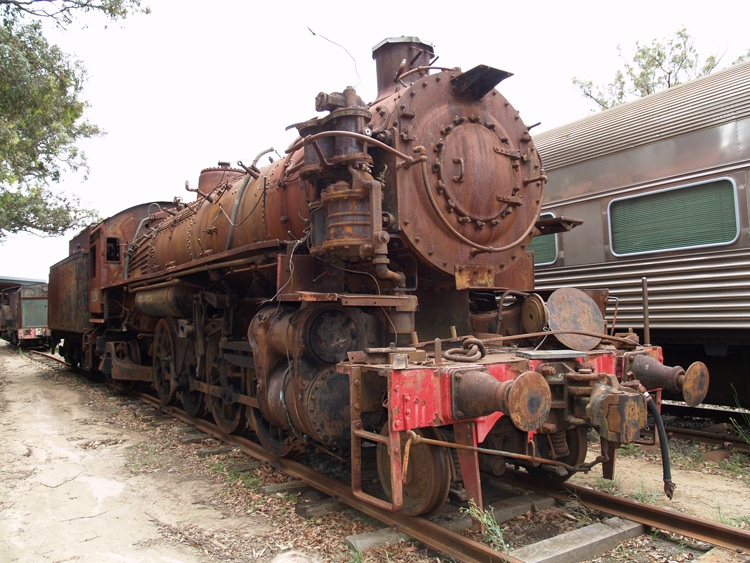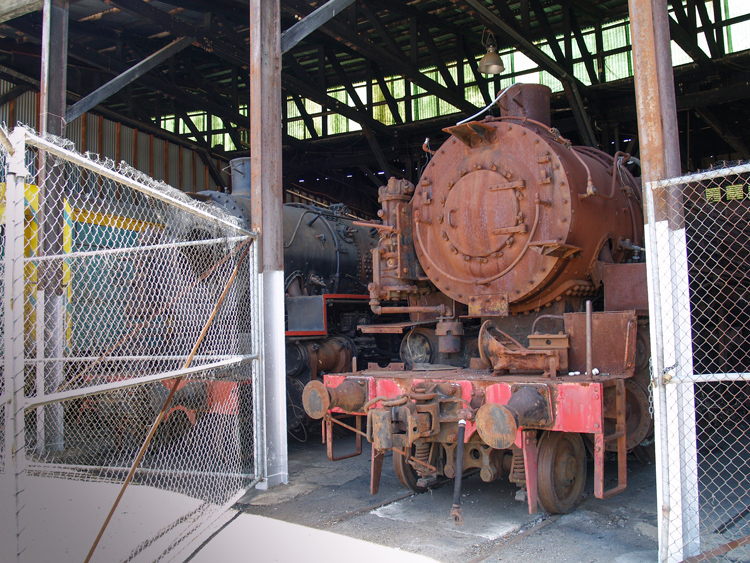|
5916 is one
of twenty (D)59 class goods locomotives ordered by the New South Wales
Government Railways (NSWGR) from Baldwin Lima Hamilton Corp, the famous
American locomotive builders Baldwin having merged with Lima-Hamilton in
December 1950. The (D)59’s were ordered at a turbulent time in the history
of Australian labour relations, with the 1949 coal strikes crippling the
railways and hence the broader economy. In response, the NSWGR specified
the (D)59 class as oil-burners, while significant numbers of the earlier
(D)55 class Standard Goods Engines were also converted to oil firing. The
NSWGR also specified short ‘bobtail’ tenders so the (D)59’s could be turned
on 60’ turntables, but the design and manufacture of these tenders delayed
the normally speedy delivery by Baldwin. The class was placed in service
between 30 August 1952 and 31 March 1953.
The
(D)59 class display typical American locomotive features such as running
plates located high above the driving wheels, a generous cab and external
pipe runs, providing easy access during maintenance but at the expense of
aesthetics. The (D)59 design was a repeat of the United States Army
Transport Corp (USATC) S200
type, designed and built for Second World War service in the
Middle-East and deployed to Egypt, Palestine and Lebanon. A number of S200 locomotives
ended up with the Italian Railways (FS Class 747), others in Iran (Trans-Iranian Railway class 42) and two batches were
purchased by the Turkish Railways, where at least two survive including 46244 at Camlik Museum. The similarity of these USATC
S200 war locomotives to the NSWGR (D)59 class is immediately apparent from
photographs, excepting the much shorter NSWGR bobtail tenders! Perhaps
larger tenders of the Turkish design would otherwise have been delivered.
The
(D)59 class were well regarded by the NSWGR, with their power, acceleration
and speed providing operational flexibility. Due to these attributes, they
were often assigned to pick-up goods duties, particularly on the ‘short
north’ main line from Sydney to Newcastle. Most class members were
converted to coal firing between 1962 and 1966, excepting 5918 (withdrawn
following accident damage to its tender and progressively cannibalised for
parts), 5908 & 5916. The two surviving oil-burners 5908 & 5916
remain largely in their original configuration as first delivered by
Baldwin Lima Hamilton; oil burning (D)59’s are easily distinguishable from
the coal-fired conversions by the smaller smokebox door, which is made
airtight by numerous ‘dogs’ around the circumference, together with the box-shaped
oil tank sitting high in tender.
Most
(D)59 class members survived until very late in the steam era, with 5910 the
last in revenue traffic when condemned on 11 August 1972. Some inactive
(D)59’s survived a few more years, with 5905, 5915 and 5920 stored at
Enfield Loco Depot until the final clear-out of that site in early 1975.
The
authorative ‘Steam Locomotive Data’ (July 1974 edition) provides the
following milestones for 5916:
|
In Service:
|
5 March 1953
|
|
Withdrawn:
|
October 1970
|
|
Distance
Travelled:
|
641,304 km
|
The two
remaining oil burners 5908 & 5916 last worked as shunters in Grafton
and dodged the scrap heap by finding further use as stationary boilers at
Broadmeadow Loco Depot, Newcastle from 1970. 5916 was transferred to
Eveleigh Carriage Workshops in August 1974 for further stationary boiler
use, with both 5908 & 5916 lasting in this capacity until 1977.
5916 was
already derelict, rust streaked and missing some parts when it arrived at
the NSWRTM Thirlmere around 1980 (much to the surprise of the webmaster,
who had been unaware of its survival). It was relegated to the long-term
storage sidings in 1983, where it remained largely out of sight to the
general public. An interesting feature in 5916’s cab was a large
information board with firing and water treatment instructions for use as a
stationary boiler. 5916 was occasionally used as a donor of motion parts
for sister 5910 when that locomotive had been operational in the NSWRTM
fleet. It received some black-oil and lubrication in 1989 to help arrest
deterioration.
5916's
old boiler lagging was removed by specialist contractors during 2008,
during which time the corroded boiler clothing sheets were removed. This
conservation treatment helps prevent pitting corrosion on the external
surface of the boiler, while also removing dangerous old insulation
material. The boiler clothing and related fittings were not replaced after
this treatment.
In
preparation for the redevelopment of the NSWRTM Thirlmere to the new
‘Trainworks’ museum, a number of exhibits were relocated to other sites. 5916,
5908 and 3085 were among this number, being moved to the Goulburn Rail Heritage
Centre (within the historic Goulburn Roundhouse) on 27 November 2009,
where they are now displayed on roundhouse roads. Here 5916 remains in
unrestored condition, however at least it is in secure storage in an
appropriate setting.
Hopefully
one day funds can be found to restore either 5916 or 5908, either
statically or – preferably - as an operable exhibit. I believe it would be
a wonderful operating exhibit which would reflect some significant themes
in period Australian history, including (as a USATC war locomotive design)
the contribution America made to the region in World War Two and
afterwards, and as an oil-burner, the 1949 coal strikes and following
labour relations & political developments. Perhaps there are also operational
benefits to having an oil-burning steam locomotive in the running fleet, such
as cheaper waste oil fuel?
The
definite history for the NSWGR (D)59 class can be found in the excellent
book ‘The 59 Class’ by Harry Wright, published by the New South Wales Rail
Transport Museum in 1996 and which features many fine colour and B&W
photographs. Some further technical details can also be found on the Wikipedia entry for the NSWGR (D)59 class.
I
would appreciate the contribution of any photographs of 5908 &/or 5916
in stationary boiler use for inclusion on this website.
|



